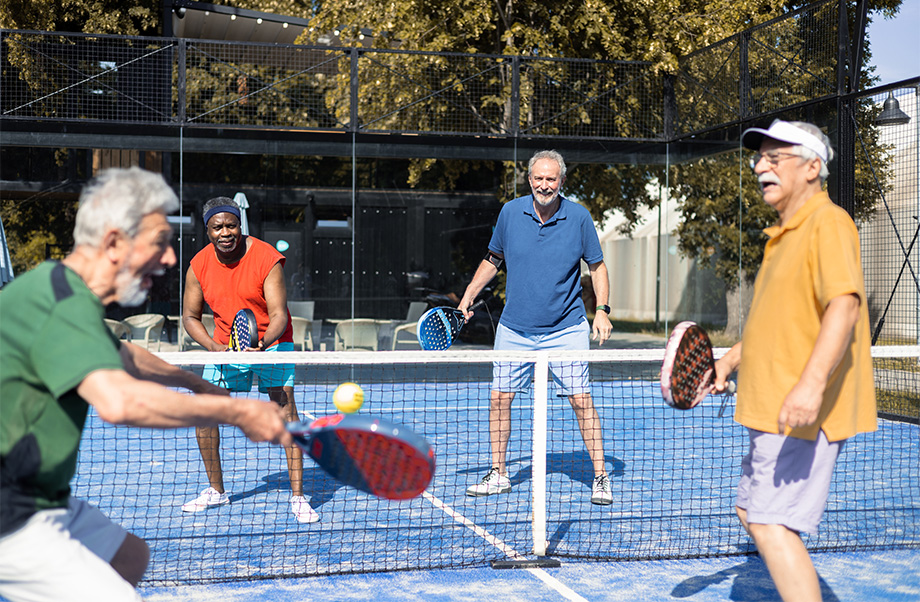It's a bit of a pickle: The injury rate for pickleball players is rising alongside the sport's popularity. UC Davis Health orthopaedic surgeons are seeing an increase in a variety of injuries, including muscle strains, fractures and more.
In other words, pickleball enthusiasts are keeping the UC Davis Health sports medicine and orthopaedic surgery teams busy!
Pickleball is played on a badminton-sized court with paddles and a ball much like a whiffleball. Especially popular with those 55 and older, it is America's fastest-growing sport. According to the Sports and Fitness Industry Association, the number of pickleball players has grown 223% over the past three years.
Injuries have also increased significantly — including fractures. Research presented at the American Academy of Orthopaedic Surgeons meeting this year found a 90-fold increase in pickleball-related factures between 2002 and 2022, especially among people aged 60-69.
In this Q&A, two orthopaedic surgeons explain the types of injuries they're seeing and share tips for avoiding getting hurt while playing this popular sport. Cassandra Lee is the chief of the Division of Sport Medicine and Mariano Menendez specializes in shoulder and elbow conditions.

What are the most common injuries you see in pickleball players?
Lee: We started seeing increases during the pandemic, when pickleball's popularity soared. Injuries vary. Most commonly we see muscle strains from overuse and exacerbation of arthritis. We also see more severe injuries requiring surgery such as Achilles tendon ruptures, ligament sprains and meniscus tears.
Menendez: I've seen a big increase in pickleball-related shoulder and elbow injuries, particularly among older adults. Common injuries include rotator cuff tears. We also see rotator cuff tendinitis and lateral epicondylitis – often called "pickleball elbow," which results from repetitive motions. I've even seen large, traumatic rotator cuff tears requiring surgery, as well as fractures of the clavicle and shoulder.
What makes these injuries unique to pickleball?
Lee: Pickleball can bring out the fierce competitors in us. It's fun and addictive, so we often want to keep playing, which predisposes us to strains and overuse injuries. Falling on these hard surfaces is often the cause of hand, wrist or other fractures whereas the quick shifting movements can cause ankle and knee sprains.
Menendez: A unique aspect of pickleball that contributes to these injuries is the combination of repetitive arm movements, quick directional changes and the sport's accessibility to older adults, who may not have a strong baseline of physical fitness. Pickleball involves frequent, intense swings with a lighter paddle, which can lead to overuse strains. The smaller court size and faster-paced play increase the likelihood of falls and sudden, awkward movements.
Falling on these hard surfaces is often the cause of hand, wrist or other fractures whereas the quick shifting movements can cause ankle and knee sprains." -Cassandra Lee, orthopaedic surgeon
Do you see more injuries in older adults?
Lee: We see overuse injuries and sprains most commonly in older adults. Fractures can also occur in our older patients because of aging-related bone loss or osteoporosis. Patients over 65 may want to see your physician to learn the status of your bone health. A DEXA bone density scan will help give you that information. If you have a family history of osteoporosis or history of fractures, you may want to get that scan earlier.
Menendez: I see injuries most often in older adults who are new to regular physical activity. This group is more prone to injuries due to decreased muscle strength, reduced flexibility and a higher likelihood of balance issues, which can lead to falls.
Pickleball involves frequent, intense swings with a lighter paddle, which can lead to overuse strains. The smaller court size and faster-paced play increase the likelihood of falls and sudden, awkward movements."-Mariano Menendez, orthopaedic surgeon
How can we avoid injuries or reduce our risk when playing pickleball?
Lee and Menendez:
- Consult your physician before starting pickleball, if you're not usually physically active.
- Aim for 150 minutes a week of regular exercise outside of pickleball to limit fatigue when playing. Great options include walking, jogging, running, swimming, biking, using an elliptical trainer or walking in a pool.
- Wear supportive, non-slip shoes that have good lateral stability.
- Warm up properly, including dynamic stretching and light cardiovascular exercises to prepare the muscles and joints for activity.
- Ramp up the duration and intensity of play gradually.
- Do strengthening exercises that focus on shoulders, core and legs to improve stability.
- Learn and practice proper playing techniques to avoid overuse strains.
- Take regular breaks and allow for rest periods.
- Listen to your body: Pay attention to pain or discomfort and address it promptly to prevent making a potential injury worse.
- Rest one day per week.
"Pickleball is fun and can bring out the competitor in you, but you shouldn't just pick up a paddle and play," Lee explained. "With any sport, you should take lessons to learn the mechanics to not only improve performance, but to limit injury.
Menendez agreed: "As a pickleball player myself, I think it's a fun sport that can be played safely with the right precautions," he said.








